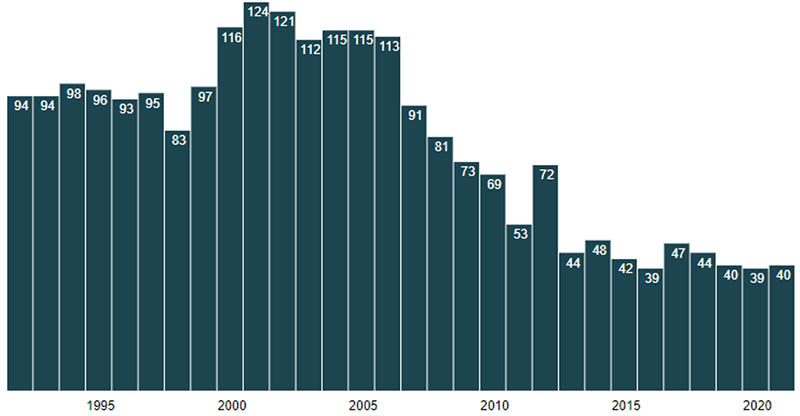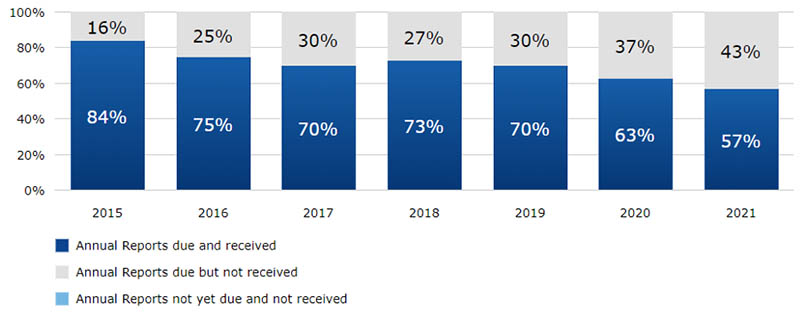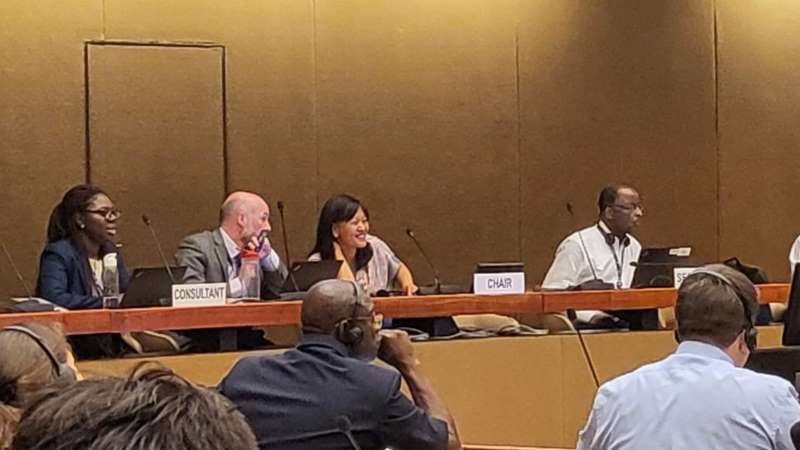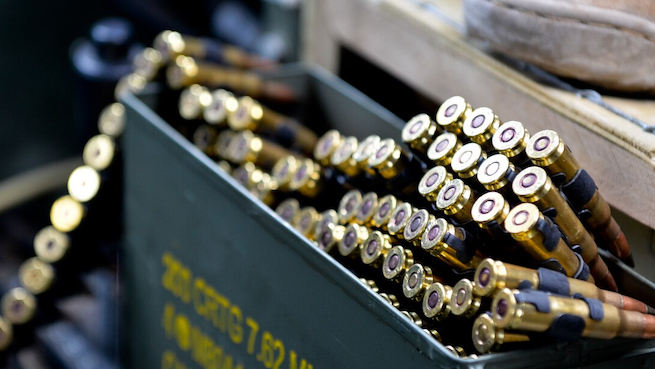14 September 2022
By the end of August 2022, 40 United Nations Member States (21 per cent of the total) had provided information on their exports and imports of conventional arms that took place in 2021 to the United Nations Register of Conventional Arms (UNROCA), including for some international transfers of small arms and light weapons (SALW). If the number doesn’t change, this will be the lowest level of reporting to the UNROCA in its 30-year history (see graph 1). Twenty years ago, more than 120 UN Member States provided information to UNROCA. Is this the end of transparency in international arms transfers?

Graph 1. UNROCA submissions (Source: UNROCA. Note: The year shown at the bottom of the graph refers to the year in which the international transfer took place, not the year in which the UN Member State submitted its data to UNROCA. For example, UN Member States are called upon to report by 31 May 2022 on international transfers of conventional arms that took place in 2021.)
Reporting, reporting, reporting
At first glance, the situation looks dire. Yet, you can find information on orders and deliveries of conventional arms via multiple open sources on your phone. Further, there are multiple international and regional conventional arms instruments that call on or even require States to report annually on their exports and imports of conventional arms. European Union Member States and parties to the Inter-American Convention on transparency in conventional arms acquisitions for example, are required to annually report on their arms exports and imports, with information made publicly available by the EU and Organisation of American States (OAS) respectively. National governments around the world provide annual reports on their arms exports and acquisitions for consideration by a national legislature or as part of sub-regional information exchanges. So, perhaps the situation is not so bad overall, and it is just that the UNROCA is dying?
Box 1. UNROCA categories of conventional arms
I. Battle tanks
II. Armoured combat vehicles
III. Large-calibre artillery systems
IV. Combat aircraft and unmanned combat aerial vehicles (UCAV)
V. Attack helicopters
VI. Warships
VII. Missiles and missile launchers
+1. Small arms and light weapons
Note: The ATT has the same titles for categories of conventional arms as UNROCA, except that category (d) in ATT Article 2(1) is “combat aircraft” and category (h) “Small arms and light weapons” is a full category in the ATT. The 2022 Group of Governmental Experts (GGE) on UNROCA has proposed a change to the heading and scope of category V, which if adopted by the General Assembly will become “Attack helicopters and rotary-wing unmanned combat aerial vehicles (UCAV)”.
Since May 2016, States Parties to the Arms Trade Treaty (ATT) have submitted annual reports on their exports and imports of major conventional weapons and SALW (see Box 1 for information on ATT categories of conventional arms). While ATT Article 13(3) encourages States Parties to provide the same information for the ATT and UNROCA, ATT annual reporting rates are higher than those for UNROCA. This is despite the fact that all UN Member States are called upon to participate in UNROCA, while just over half of UN Member States are obliged to report on international arms transfers to the ATT Secretariat. Yet, whereas all submissions to UNROCA are publicly available, ATT States Parties can opt for their annual report to only be made available for other ATT States Parties. Of the 63 States Parties that had submitted their annual report for 2021 by 24 August 2022, 22 (35 per cent) had chosen not to make their report publicly available. Looked at this way, the figures for publicly reporting on arms exports and imports for the ATT and UNROCA look very similar, with 40 UNROCA submissions and 41 ATT annual reports publicly available. So, it is not just UNROCA that is failing to boost public reporting on international arms transfers.

Graph 2. ATT reporting 2015-2021 (Source: ATT Secretariat. Note: The year shown at the bottom of the graph refers to the year in which the international transfer took place, not the year in which the ATT State Party submitted its data on international transfers of conventional arms to the ATT Secretariat. For example, ATT States Parties are obliged to submit an annual report by 31 May 2022 on imports and exports of conventional arms that took place in 2021.)
Public reporting on arms exports continues…
While the ATT and UNROCA have not (yet) clearly established the norm of public reporting on international arms transfers, the world’s largest arms exporters have used both mechanisms to publicly report on arms exports. The top 20 largest arms exporters for the period 2012-2021, according to the Stockholm International Peace Research Institute’s (SIPRI) arms transfer database, have all made information on arms exports publicly available via the ATT or UNROCA. Only a handful of these States made information on their arms exports publicly available 30 years ago.
SIPRI estimates that these States account for 98% of the global volume of international arms transfers. Therefore, ATT annual reports and UNROCA should provide a good overview of the global flow of conventional arms. Unfortunately, SIPRI data also shows that the nature of the international arms trade is changing, with many states turning to licensed production and technology transfer arrangements under which complete weapons systems do not travel from country A to country B, but conventional arms are produced or assembled in the “importing” state and thus not reported by States as an “international transfer”.
…but what about reporting on acquisitions?
Member States can provide information on all forms of acquisitions of major conventional arms to UNROCA – via import and national production. Participation in UNROCA is voluntary, but providing information on procurement through national production is considered an additional secondary layer of information compared to reporting on imports – and only four States provided such information in their submission for acquisitions in 2021 (i.e. in their 2022 submission). Since 1994, GGEs have been appointed by the UN Secretary General to consider how to enhance the operation, increase participation, and ensure the relevance of the UNROCA. The issue of upgrading reporting on procurement through national production has been considered by every group. The only recommended change has been made by the 2022 GGE, which provides a reference form for use by those Member States that elect to provide such information.

The authors, UNIDIR’s Anna E. Mensah (far left) and Paul Holtom (second left), consult with Chair Muanpuii Saiawi during the 2022 Group of Governmental Experts on the UN Register of Conventional Arms.
While changing the status of reporting such information could help to show that UNROCA does not require Member States that acquire their conventional arms via imports to be more transparent than those that acquire their arms via national production, it is unlikely to help overcome some of the main challenges for increasing participation. Many Member States have limited capacities and under-developed (or non-existent) national procedures for collecting and processing data on international arms transfers for the ATT and UNROCA, but is a technical approach sufficient for increasing public reporting on arms exports and imports, as well as procurement through national production?
Can we reverse the decline in public reporting on international arms transfers?
The 2022 GGE on the UNROCA and the ATT Working Group on Transparency and Reporting (WGTR) have provided many good ideas for building national capacities to enable data collection and processing to compile UNROCA submissions and ATT annual reports, with a focus on supporting national points of contact responsible for coordinating such report compiling processes. Both have also highlighted opportunities for international cooperation and assistance to support such efforts, as well as identifying the benefits for increasing trust and building confidence between States and helping to identify potential conflict and diversion risks by examining reports and engaging with States and international and regional organizations on these issues. It is critical that efforts to increase public reporting on international arms transfers address the specific challenges faced by individual States, rather than adopting a one-size-fits-all approach for explaining the benefits and alleviating the administrative burden of reporting.
The Seventh Conference of States Parties to the ATT also endorsed an amendment to the annual reporting format that asks if relevant information contained in the ATT annual report could be used by the United Nations Office for Disarmament Affairs (UNODA) as the basis for its UNROCA submission. In 2022, some 18 ATT States Parties indicated that their ATT annual report could be used in such a manner. At the time of writing, UNODA has not yet processed this information, so it is not yet clear if these 18 States have already submitted information to UNROCA or if this will lead to an increase in the number of UNROCA submissions for 2022. Yet such efforts to explore if one report can satisfy multiple reporting commitments and obligations to reduce national reporting burdens appears to be a positive development.
One hopes that all States will publicly report on their arms exports and imports to provide opportunities to understand international arms flows. Conventional arms continue to be the main weapons used in conflicts around the world, causing death and destruction, setting back socioeconomic development, and slowing progress towards the Sustainable Development Goals. While open sources provide some information on the flows into conflict areas, it is only public reporting by States that can provide genuine trust and confidence-building. Thus, transparency in international transfers and the acquisition of conventional arms through national production remains as important for international peace and security today as it was 30 years ago.
Paul Holtom is the Head of the Conventional Arms and Ammunition Programme at UNIDIR, where Anna Edna Esi Mensah is also an Associate Researcher. The authors served as consultants to the 2022 Group of Governmental Experts on the United Nations Register of Conventional Arms.
